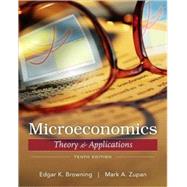
Note: Supplemental materials are not guaranteed with Rental or Used book purchases.
Purchase Benefits
What is included with this book?
| An Introduction to Microeconomics | |
| The Scope of Microeconomic Theory | |
| The Nature and Role of Theory | |
| Positive Versus Normative Analysis | |
| Market Analysis and Real Versus Normal Prices | |
| Basic Assumptions about Market Participants | |
| Opportunity Cost | |
| Production Possibility Frontier | |
| Supply and Demand | |
| Demand and Supply Curves | |
| Determination of Equilibrium Price and Quantity | |
| Adjustment to Changes in Demand or Supply | |
| Government Intervention in Markets: Price Controls | |
| Elasticities | |
| The Mathematics Associated with Elasticities | |
| The Theory of Consumer Choice | |
| Consumer Preferences | |
| The Budget Constraint | |
| The Consumer's Choice | |
| Changes in Income and Consumption Choices | |
| Are People Selfish? | |
| The Utility Approach to Consumer Choice | |
| The Mathematics Behind Consumer Choice | |
| Individual and Market Demand | |
| Price Changes and Consumption Choices | |
| Income Substitution Effects of a Price Change | |
| Income and Substitution Effects: Inferior Goods | |
| From Individual to Market Demand | |
| Consumer Surplus | |
| Price Elasticity and the Price-Consumption Curve | |
| Network Effects | |
| The Basics of Demand Estimation | |
| Deriving the Consumer's Demand Curve Mathematically | |
| Using Consumer Choice Theory | |
| Excise Subsidies, Health Care, and Consumer Welfare | |
| Public Schools and the Voucher Proposal | |
| Paying for Garbage | |
| The Consumer's Choice to Save or Borrow | |
| Investor Choice | |
| Exchange, Efficiency, and Prices | |
| Two-Person Exchange | |
| Efficiency in the Distribution of Goods | |
| Competitive Equilibrium and Efficient Distribution | |
| Price and Nonprice Rationing and Efficiency | |
| Some of the Mathematics behind Efficiency in Exchange | |
| Production | |
| Relating Output to Inputs | |
| Production When Only One Input is Variable: The Short Run | |
| Production When All Inputs are Variable: The Long Run | |
| Returns to Scale | |
| Functional Forms and Empirical Estimation of Production Functions | |
| The Mathematics behind Production Theory | |
| The Cost of Production | |
| The Nature of Cost | |
| Short-Run Cost of Production | |
| Short-Run Cost Curves | |
| Long-Run Cost of Production | |
| Input Price Changes and Cost Curves | |
| Long-Run Cost Curves | |
| Learning by Doing | |
| Importance of Cost Curves to Market Structure | |
| Using Cost Curves: Controlling Pollution | |
| Economies of Scale | |
| Estimating Cost Functions | |
| The Mathematics behind Production Cost | |
| Profit Maximization in Perfectly Competitive Markets | |
| The Assumptions of Perfect Competition | |
| Profit Maximization | |
| The Demand Curve Facing the Competitive Firm | |
| Short-Run Profit Maximization | |
| The Perfectly Competitive Firm's Short-Run Supply Curve | |
| The Short-Run Industry Supply Curve | |
| Long-Run Competitive Equilibrium | |
| The Long-Run Industry Supply Curve | |
| When Does the Competitive Model Apply? | |
| Using the Competitive Model | |
| The Evaluation of Gains and Losses | |
| Excise Taxation | |
| Airline Regulation and Deregulation | |
| City Taxicab Markets | |
| Consumer and Producer Surplus, and the Net Gains from Trade | |
| Government Intervention in Markets: Quality Controls | |
| Monopoly | |
| The Monopolist's Demand and Marginal Revenue Curves | |
| Table of Contents provided by Publisher. All Rights Reserved. |
The New copy of this book will include any supplemental materials advertised. Please check the title of the book to determine if it should include any access cards, study guides, lab manuals, CDs, etc.
The Used, Rental and eBook copies of this book are not guaranteed to include any supplemental materials. Typically, only the book itself is included. This is true even if the title states it includes any access cards, study guides, lab manuals, CDs, etc.